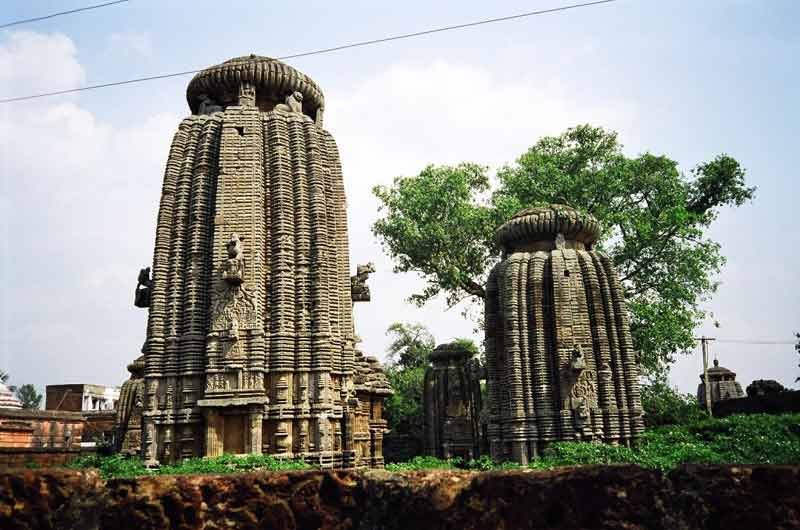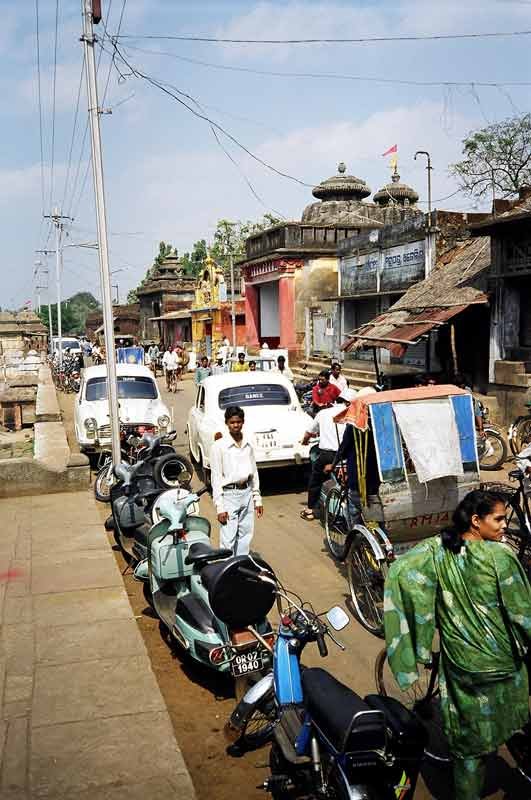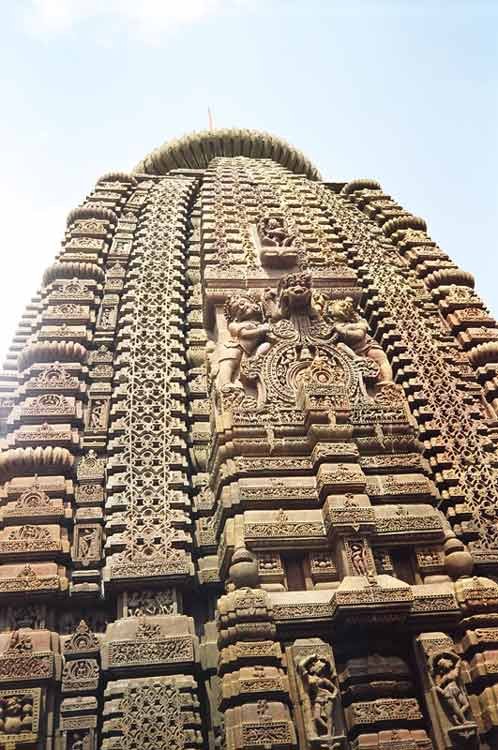Lingaraj Mandir
The following is an extract from the travel book A River of Life: Travels through Modern India.

Despite the five hundred year hiatus of iconoclastic raids, the people of Orissa remain somewhat wary of non-Hindus, at least as far as their religious sites are concerned. Almost all of the active ones are closed to non-Hindus, including, disappointingly, the most renowned one in the whole of Bhubaneswar, the Lingaraj Mandir.
I head that way anyway. It is a fine day for strolling, a typical Indian-summer day: lush and calm, blue, a little hazy.
A feeling of dislocation overcomes me, a displacement of the senses. Why, I wonder, does everything seem so colourful and
immediate? I have a suspicion that the quality of light has something to do with it, somehow improved on what I am used to,
 toning up the colours and making them warmer, sharper. But I am not sure: one of the reasons Orissa is so poor, along with
modest soil quality and erratic monsoons, is the low level of sunlight it receives compared to other areas of the country.
According to one slightly contentious theory, the human eye has adapted since the time of the ancient Greeks, to encompass a
broader spectrum of colour: Homer's wine-dark sea, for him a deep purple, or burgundy perhaps, is for us a decidedly different
and more distinctive hue. I can almost believe that some such evolutionary leap has taken place in me following my journey
through time zones and degrees of latitude. A cow nudges its way past me as I negotiate a bottleneck outside a small squat
temple, and I am impressed by the blackness of its rump and the redness of a welt on its left front hoof. Boys dive into the
water of Bindu Sagar, a shimmer of broad green under the morning sun. Their discarded shirts on the platform are as bright
and gay as the saris of women going past me. I can't help but wonder how the changes have been wrought.
toning up the colours and making them warmer, sharper. But I am not sure: one of the reasons Orissa is so poor, along with
modest soil quality and erratic monsoons, is the low level of sunlight it receives compared to other areas of the country.
According to one slightly contentious theory, the human eye has adapted since the time of the ancient Greeks, to encompass a
broader spectrum of colour: Homer's wine-dark sea, for him a deep purple, or burgundy perhaps, is for us a decidedly different
and more distinctive hue. I can almost believe that some such evolutionary leap has taken place in me following my journey
through time zones and degrees of latitude. A cow nudges its way past me as I negotiate a bottleneck outside a small squat
temple, and I am impressed by the blackness of its rump and the redness of a welt on its left front hoof. Boys dive into the
water of Bindu Sagar, a shimmer of broad green under the morning sun. Their discarded shirts on the platform are as bright
and gay as the saris of women going past me. I can't help but wonder how the changes have been wrought.

"Hello?" a rickshaw man says, as interested in me as I am in the tricks of the light. "You are going?"
I signal where, to show I don't need his services. The Lingaraj Temple is visible in the near distance, or at least its sikhara is, a tower with the same beehive structure as the main tower of the Mukteswara Mandir and most of Bhubaneswar's other ancient sandstone temples. It rises elegantly above the line of buildings on the south side of Bindu Sagar, its crimson pennants astir in the breeze.

The precincts outside are bustling with devotional goings-on: people gathering, going in, coming out, haggling over the price of coconuts and white and yellow bands of flowers at stalls at the entrance, purchases they would offer as prasad to the god within, Tribhubaneswar, the Lord of Three Worlds - earth and sea and sky - to whom the temple is dedicated and after whom the city derives its name.
I circle round the compound, exploring the lesser-seen nooks and crannies. Over by the north wall there is a viewing platform, constructed at the turn of the century for the visit of Lord Curzon, Viceroy of India. The platform offers a limited view of the temple's interior. The temptation to climb it is strong. Temples in India are and always have been great places for social activity, serving in the past as banks, schools, administrative centres for villages and local communities, and still serving, besides mere places of worship, as employers of artisans and servants, centres of religious discussion, places for major entertainments in the form of festivals.
I elect not to climb the platform all the same. If non-Hindus are not allowed inside, I should respect that. A gaze can be as intrusive to the devout as physical presence.
Temples etc.
A River of Life
Read on...
Read the next article about Arjuna's penance.
Popularly known as Arjuna's Penance, the largest bas-relief in Mamallapuram is also the largest in the world, measuring some 90 feet long, some 30 feet high, carved onto the face of a boulder that had once formed part of a large cliff face. It has other names too, reflecting the fact that no one is quite sure what it depicts: Bhagiratha's Penance and Decent of the Ganges are other favourites.
Go back...
Read the previous article about evening worship at Varanasi.
According to Hindu mythology, the Ganges was brought into being by the prayers of one of the devout, issuing from the foot of Vishnu and flowing to earth through the locks of Shiva's hair. As I come within sight of the river, I can see how such a myth might have originated; the water, flowing sleekly along, is a mass of darkness, billowing like locks of lustrous black hair.

Available for purchase now
Sheldon's account of his overland travels around India, A River of Life, is available for purchase now. Buy the e-book from Amazon.com or Amazon.co.uk, or the paperback from Amazon.com or Amazon.co.uk (also available in other countries, search Amazon for more information).
The first instalment, A River of Life, Book 1: Travels in the North, is available separately (e-book format only) via Amazon.co.uk or Amazon.com. The second instalment, A River of Life, Book 2: A Tour of the South, is available via Amazon.co.uk or Amazon.com.
